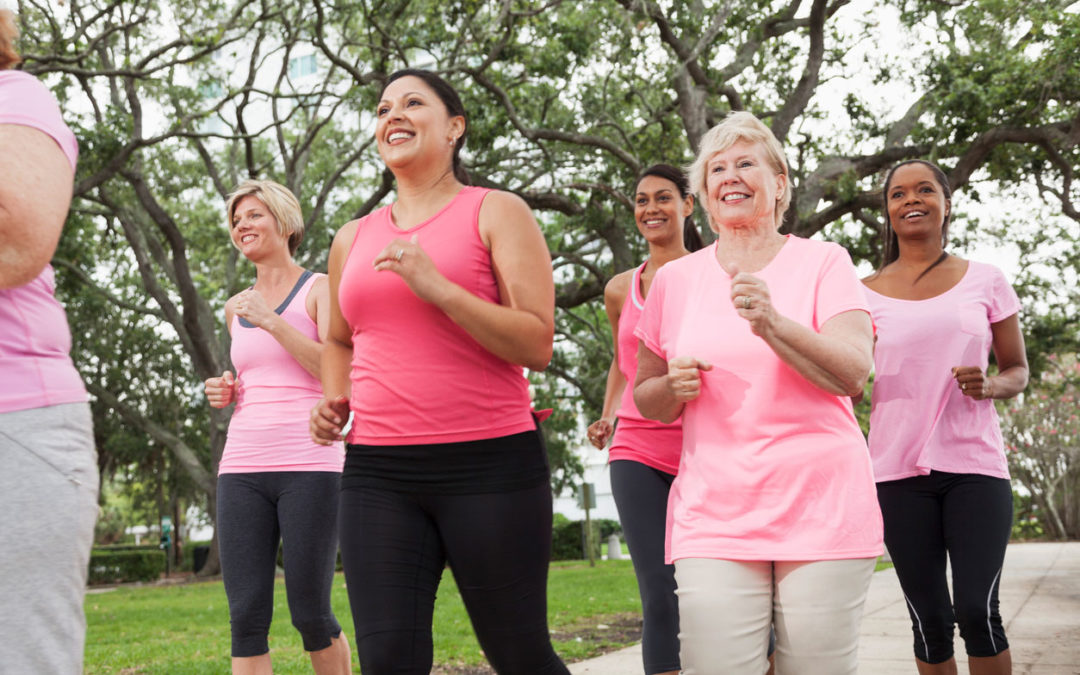It’s not uncommon to scroll past or flick through newspapers or Facebook without someone mentioning a new “miracle” cure to cancer. So when you see titles claiming that exercise can prevent, cure or help with cancer recovery it probably sounds too good to be true, right?
Being diagnosed with breast cancer has its challenges, time off work and medical bills that result in financial difficulties, lots of emotions you probably weren’t aware of and long lists of side effects. While the whole process is horrible and I wouldn’t wish it upon anyone, I’m here to try and educate you on how you can best deal with the diagnosis and treatment process in order to make that time even the tiniest bit better for you or someone you know!
Now that I’m sitting here and about to write how much exercise can help in the way of recovery you’re probably thinking I’m a crazy person – that exercise is probably the last thing you’re going to want to feel like doing when you’re tired and sore and have 0 motivation. But hear me out…
Everybody loves lists, so how about one on all the things moderate physical activity will assist with
- Maintenance of bone mineral density
- Manage and reduce cancer related fatigue
- Improve mood
- Manage flexibility and mobility
- Improve appetite and reduce nausea
- Reduction in overall side effects
- Improvement in upper body strength and endurance
- Improve and maintain aerobic conditioning
So how much is enough?
Firstly, it’s important to understand that one’s “moderate” level of exercise is another person’s “are you kidding me no way”. With that being said, there are some guidelines for exercising with cancer which have been agreed on by a range of different professionals. The approach now is much different to how it has been in the past where people have recommended to rest! It was thought that exercise may be harmful and exacerbate fatigue in individuals who have undergone intensive treatment such as chemotherapy. In saying this, it might come as a surprise but the current guidelines for cancer patients are no different to those for people who don’t have cancer.
Overall the general guideline is to engage in 30 minutes of moderate physical activity on most days (5+) per week. If this sounds like a big ask then take a step back and break these up into little chunks of 10 minutes throughout your day – a little change that will seem so much more achievable. Moderate level basically means that you want a slight increase in heart rate, body temperature and breathing rate, but nothing too over the top.
What type of exercise?
I can’t stress enough that the exercise you undertake should be something that you genuinely enjoy. Exercise may seem like it’s impossible to do when you’re feeling all the side effects after surgery and treatment, but if you are looking forward to or excited about an exercise, sport or activity then it will be so much easier for you to achieve. Use this as your time to yourself away from appointments, specialists, results and waiting rooms! Any exercise is better than being sedentary, so maybe play around with a few things to see what you enjoy. Running, cycling, hiking, you name it!
Remember!
- Start off small, the first walk after treatment could feel like you just ran a marathon. Don’t beat yourself up about it as there are many feasible reasons as to why you feel like you do!
- It can definitely help to have a partner or work out buddy, to be there not only for support but motivation – everyone feels more responsible to exercise if they have someone there waiting for them.
- Keep a diary on how you’re feeling, this can help you to track your progress along the way. A lot of the time we get disheartened when we don’t see large results after a while but this is a way to show the little progressions we sometimes forget, which can be just as motivating.
- Be aware of lymphedema! A big word meaning swelling of the upper arm or limb that can occur in individuals who have had lymph nodes removed during surgery. The good news – exercise actually helps with the onset and symptoms of lymphedema.
Seek the guidance of an exercise physiologist, they specialise in the prescription of appropriate exercise that will be tailored to you. They will also be able to help guide you through this difficult stage. I’m not saying you need to go join a gym and smash out a 2 hour workout (which is both a big ask and probably a little un-realistic). Take it slow and get your body moving, it may not feel like it at the time but it will do your body a world of good!
References:
Bcna.org.au. (2018). [online] Available at: https://www.bcna.org.au/media/2129/bcna_exercise_and_breast_cancer_booklet_0.pdf [Accessed 10 Apr. 2018].
Cancer Council NSW. (2018). Exercise and Cancer | Cancer Council NSW. [online] Available at: https://www.cancercouncil.com.au/get-support/exercise-and-cancer/ [Accessed 10 Apr. 2018].
Dieli-Conwright, C. and Orozco, B. (2015). Exercise after breast cancer treatment: current perspectives. Breast Cancer: Targets and Therapy, p.353.
Ramirez-Velez, R., Meneses-Echavez, J. and Barengo, N. (2014). Supervised Resistance Training On Cancer-related Fatigue In Breast Cancer Survivors. Medicine & Science in Sports & Exercise, 46, p.543.
Schmidt, M., Wiskemann, J. and Steindorf, K. (2014). Exercise in breast cancer patients: impact on health. Breast Cancer Management, 3(3), pp.241-250.
